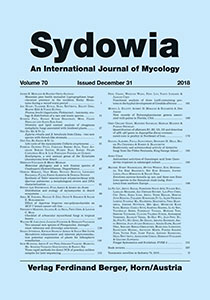
Diversity and lipid content analysis of oleaginous endophytic fungi associated with biodiesel plants Susmita Paul, Ranjan Kumar Bhagobaty, Mool Chand Nihalani and Santa Ram Joshi Sydowia 70: 27-35 Published online on April 30th, 2018 A total of six biodiesel plants, Jatropha curcas, Pongamia pinnata, Sapindus mukorossi, Mesua ferrea, Terminalia bellerica and Cascabela thevetia were collected for isolation of oleaginous endophytic fungi; 25 strains were isolated from 140 segments of plant samples. The internal transcribed spacer regions (ITS) of the strains were sequenced and the phylogenetically analysed. Isolation rate (IR) and relative frequency (RF) was calculated for the endophytic fungi found. A total of 11 strains belonged to the genera Colletotrichum, Diaporthe and Phomopsis. Among the six plant species fungal diversity was found to be equally high in Jatropha curcas and Cascabela thevetia. Lipid content analysis was done for each isolate and four isolates were found to be oleaginous producing more than 20 % total lipid content of their dry biomass. Screening of hydrolytic enzymes such as amylase, cellulase, lipase and protease was done for the four positive isolates. The enzymatic activities were evaluated by the formation of a clear halozone/white precipitate around the colonies in defined substrate media. All the isolates were positive for lipase production. The highest enzymatic index of 5.33 for amylase and 4.26 for lipase production was observed in Pestalotiopsis microspora SPSRJL35. Protease activity was found to be poor in all isolates with an enzymatic index of less than 2. Keywords: Isolation rate, relative frequency, phylogeny, enzymatic index. |
 |